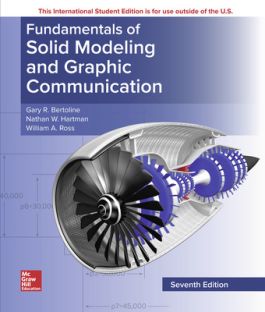Fundamentals of Graphics Communication ISE
1260289656
·
9781260289657
A thoroughly contemporary approach to teaching essential engineering graphics skills has made Fundamentals of Solid Modeling and Graphics Communication the leading textbook in introductory engineering graphics courses. The seventh edition continues t…
Read More
After purchasing your eBook, login to the McGraw Hill Bookshelf website and redeem the access code from your order confirmation email.
- Access your eBook online or offline
- Easily highlight and take notes
- Fully searchable content
- Syncs across platforms
NOTE: eBook purchase does not include Connect homework or adaptive SmartBook assignments
1 The Design Process
2 Role of the 3D Model in the Product Lifecycle
3 Sketching and Basic Geometry Definition
4 Feature Based Modeling
5 Introduction to Assembly Modeling
6 Product Manufacturing Information (PMI)
7 Standard Parts
8 Data Management, Exchange, and Translation
9 Leveraging the 3D Model in the Product Lifecycle
10 Engineering Drawings from Parts and Assembly Models
Appendices
Glossary
Index
A thoroughly contemporary approach to teaching essential engineering graphics skills has made Fundamentals of Solid Modeling and Graphics Communication the leading textbook in introductory engineering graphics courses. The seventh edition continues to integrate design concepts and the use of 3D CAD modeling into its outstanding coverage of the basic visualization and sketching techniques that enable students to create and communicate graphic ideas effectively.
The primary goal of this text is to help the engineering and technology student learn the techniques and standard practices of technical graphics, so that design ideas can be adequately communicated and produced.
As in past editions, the authors have included many examples of how graphics communication pertains to "real-world" engineering design, including current industry practices and breakthroughs.
The primary goal of this text is to help the engineering and technology student learn the techniques and standard practices of technical graphics, so that design ideas can be adequately communicated and produced.
As in past editions, the authors have included many examples of how graphics communication pertains to "real-world" engineering design, including current industry practices and breakthroughs.

